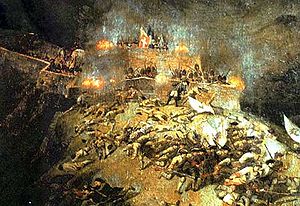Battle of Assietta
| Battle of Assietta | |||||||
|---|---|---|---|---|---|---|---|
| Part of the War of the Austrian Succession | |||||||
 The death of the Chevalier de Belle-Isle |
|||||||
|
|||||||
| Belligerents | |||||||
|
|
|
||||||
| Commanders and leaders | |||||||
| Louis Fouquet de Belle-Isle † | |||||||
| Strength | |||||||
| 32 Battalions | 13 Battalions | ||||||
| Casualties and losses | |||||||
| 5,300 | 299 | ||||||
The Battle of Assietta was fought in the Italian campaign of the War of the Austrian Succession on 19 July 1747. It resulted in a defeat for France against the army of the Kingdom of Sardinia.
In the late phase of the War of the Austrian Succession, France had decided to eliminate the Savoyard army, considered dangerous due to its strong strategic position. King Louis XV had already tried to penetrate into Piedmont, besieging Cuneo and fighting at Madonna dell'Olmo and Bassignana.
A French army comprising 150 infantry regiments, 75 cavalry squadrons and 2 artillery brigades, under the command of Marshal Charles Louis Auguste, duke of Belle-Isle, and Marquis De La Mina. The two commanders had different views on the lead of the campaign: Belle-Isle favoured a direct menace to Turin by crossing the Alps, while his Spanish colleague preferred to send troops to relieve the Austro-Sardinian siege of Genoa.
Belle-Isle's ideas prevailed and the French troops occupied Antibes as well as the county of Nice. However, they were halted by the strong Sardinian defence of the southern Alpine passes. Belle-Isle's brother, the Chevalier de Belle-Isle, led an army of 50 infantry battalions, 15 cavalry squadrons and numerous cannon advanced towards the northern passes.
The army was divided into two corps: one descended from the Moncenisio towards Exilles while the other advanced towards Fenestrelle from the Assietta Pass. The latter is a bare plateau at more than 2,500 meters of altitude. Although he outnumbered the French in the area 50,000 to 25,000Charles Emmanuel III of Savoy was forced to defend all the passes into his country while the French could concentrate their force and attack one place. The decision was made to advance through Assietta. The Sardinian had fortified the area with 13 infantry battalions: 9 Sardinian, the remaining were Austrian and Swiss taken from the troops that had unsuccessfully besieged Genoa.
...
Wikipedia
